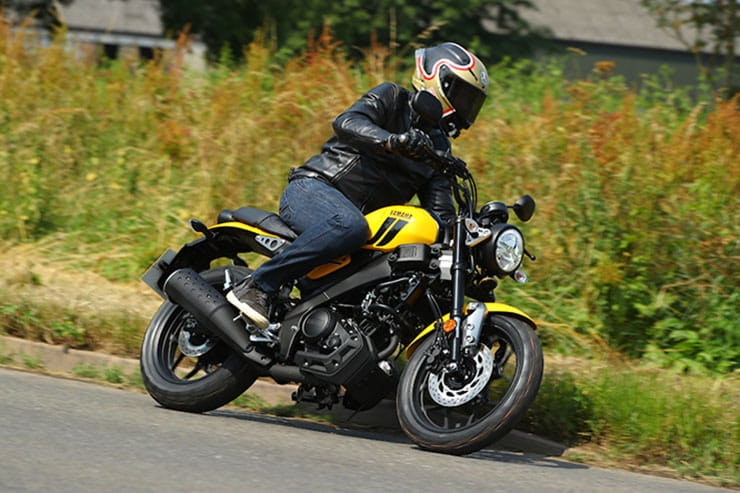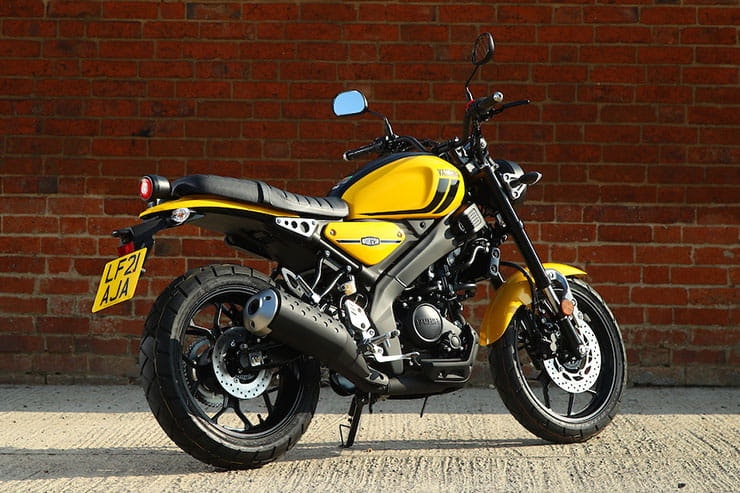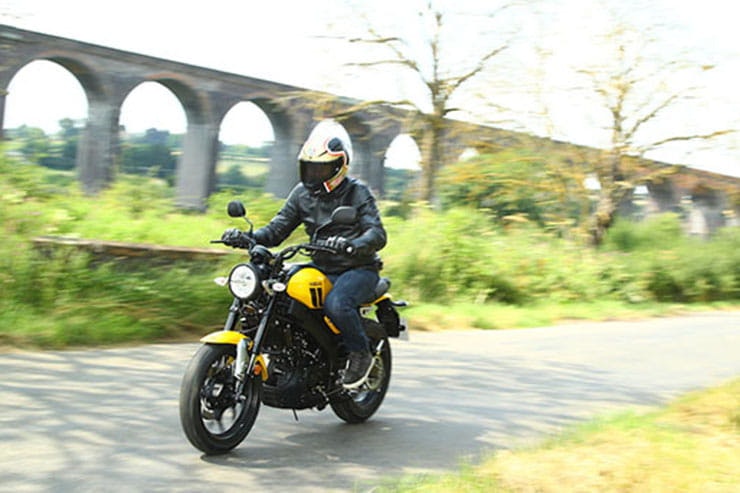Yamaha XSR125 (2021) - Review
By Michael Mann
BikeSocial Managing Editor. Content man - reviewer, road tester, video presenter, interviewer, commissioner, organiser. First ride was a 1979 Honda ST70 in the back garden aged 6. Not too shabby on track, loves a sportsbike, worries about helmet hair, occasionally plays golf and squash but enjoys being a father to a 7-year old the most.
22.07.2021
Kit Credits
Helmet
AGV Pista GP-RR (with custom paint job from LDC Designs), £999.99 | www.agv.co.uk
Jackets
Dainese Settantadue Chiodo, £128.98 (at the time of writing) | www.dainese.com
Dainese Smart Jacket (airbag), £649.95 | www.dainese.com
Trousers
Dainese Denim Jeans (previous season) | www.dainese.com
Gloves
Dainese Carbon D1, £109.95| www.dainese.com
Boots
Dainese York Air, £145.95 | www.dainese.com
The XSR125 is a stylish old-but-new A1 licence-friendly motorcycle fresh out of the Yamaha box for summer 2021, using the swanky and highly rated Euro 5-compliant, liquid-cooled, single-cylinder, 4-stroke, 125cc engine as seen in its new stablemates, MT-125 and YZF-R125. Of course, 55-years ago the first ever Yamaha motorcycle was also a single cylinder, 125cc, known as the YA-1.
Not only does the latest addition to the XSR range, also known as ‘Sport Heritage’ (‘designed from yesterday, built for the future’ so says the marketing comms), encourage newcomers to Yamaha with a path eventually leading them towards the XSR700 and then XSR900, but the 125 version looks remarkably like a bigger bike. Despite being compact and narrow-waisted, this little bustler feels as sturdy and strong as a bigger machine. It’s fresh, solid, grown-up with plenty of quality detailing and dives head-first into a thriving market. Across Europe, this A1 category grew 21% in 2020, while in the UK it accounted for more than 20,000 sales with 2021 already looking like it’ll beat that. Though the impressive figures can be partially attributed to the increase in popularity of take-away delivery riders as well as so many commuters steering clear of public transport.
We took it around the lanes and towns of central England for the UK press launch.
Style: too school for cool
Top details: LED lights, LCD dash, aluminium parts
Value for money: less than £50 per month with a +130mpg return
Engine: sprightly, revvy, classy
No storage, not even for a Twix
No USB charging socket: they’re all the rage, especially for the target market
Premium price may alienate some before they ride
Come for a ride on the 2021 Yamaha XSR125
BikeSocial’s Michael Mann offers an in-depth look around the new Yamaha XSR125
Yamaha XSR125 (2021) Price
How much is the 2021 Yamaha XSR125? £4,450
Looking at the RRP alone for a learner-friendly bike is certainly a large part of what might persuade the buyer to part with their cash but it’s not the full story. Think of running costs, future servicing, the quality of the brand and the bikes components as well as residual value should you buy outright or via a PCP deal.
And all that goodness can be yours for less than £49 per month… or just £1.61 per day. About what you pay for a muffin from Starbucks, right? Here’s a representative PCP deal from Yamaha Motor Finance:
It’s available right now from UK dealers in three colours: Tech Black, Redline or Impact Yellow.
Power and Torque
Engineers at every manufacturer are all too aware of the maximum performance figures permitted for the A1-licence category and develop their engines to within a whisker of the limit, so virtually every version comes with a claimed 11kW / 11.4bhp peak power figure.
The single-cylinder Yamaha hits its peak power way up the rev range at 10,000rpm which you’d expect to feel quite vibey but alas, despite being desperate for revs, the XSR125 remains relatively calm but still emits a deep and almost diesel-like ‘zing’ from its overly large single-sided silencer.
Peak torque is measured at 8.5 ft-lbs or 11.Nm at 8000rpm but that doesn’t tell the full story…
Engine, Gearbox and Exhaust
As per the MT-125 and YZF-R125 with which this XSR125 shares its motor, it too comes equipped with a secret weapon – VVA, or Variable Valve Actuation. We’ve heard of big, powerful engines being to be create a switch in performance to assist spreading the torque wider in the range, to keep in line with emission regulations and to improve economy too though it’s not a familiar piece of technology in this learner segment. ‘Low lift’ becomes’ ‘High lift’ at 7400rpm allows the valve timing to be switched. The different cam profiles means one is suited for torque and low speed then changed for better high end.
Is it noticeable? Nope, when accelerating through that point in the rev range you wouldn’t notice a step change, it simply keeps climbing quickly towards the 9-10k rpm mark. And that’s the point; at low speed there’s enough acceleration to get off the line quickly while it maintains a strong and lively personality at the top.
In terms of performance then 0-30mph will see a couple of gear changes but the lightweight XSR can get to the city speed limits with little embarrassment. Wind it up, use the revs and 5th gear will just about get beyond 70mph so long as there’s no uphill sections. 6th gear is for the cruising, relaxing and maxxing the mpg as opposed to focusing on maintaining momentum among traffic or out in the wilds of Rutland.
A slick 6-speed ‘box is accompanied by a very light clutch lever and change action. If you’re feeling rebellious then a slight light and no clutch will still allow for an upchange, but all you really need is the lightest of clutch pulls and only by a couple of centimetres too. There’s an assist-and-slipper clutch for the downshifts so the rear doesn’t lock.
The engine note is a little screamy but look at the facts; it’s a single-cylinder 125 that revs beyond 10,000rpm – but it loves life higher in the rpm range so feel free to rip that throttle back if you’re not bothered about being rev-shamed by passers by. The exhaust note is a little tinny, even diesel-like down low though the style of the silencer fits with that heritage feel of the XSR.
Yamaha XSR125 (2021) Comfort and Economy
To comply with the Sport Heritage/Faster Sons theme of the XSR range, the roll and tuck bench-style seat might fit the part by being flat and narrow-waisted but it’s hard. Now just to put a little context in, we rode on a ridiculously hot day primarily on bouncy b-roads which is not the bike’s true home ground. Uneven back streets, fairly budget suspension and a stylised motorcycle on a scorching day aren’t a comforting mixture but the riding position certainly is. Slightly less sporty than the MT-125 and with 15mm wider bars means the XSR experience is enchanting enough to sit up and relax when you need to, while at 6ft tall and 14 stones I’d normally expect to fill a 125. Though despite its lightweight, 140kg (2kg less than the MT) and rather compact statue, the 125 feels closer to the 700 in terms of size. There’s plenty of space for legs and arms and while I wouldn’t encourage a pillion to join me, there’s enough room for two. Among our riding group were two whipper snappers who looked like they were riding a bike of larger capacity, while on the flip side, a couple of post 3-course lunch sized chaps did look too well suited.
On the economy side, EU5-compliance has in most cases improved mpg, and that certainly true with the little Yamaha. Claimed mpg figures of 134.5 meant a theoretical range of 300+ miles from the 11-litre tank. Let a bunch of lunatics lose and with a little encouragement I just managed to get the average mpg just under 100, according to the rather fancy circular inverted LCD display. So even with plenty of throttle on/off-ing the 125cc still keeps you going for twice as long between fill-ups than my long-term Multistrada V4S.
Handling, Suspension and Weight
Tight turning circles, easy manoeuvring at low or even no speed and a cinch to swing a leg over and flat foot are all must-haves with A1 licence bikes and the Yamaha can tick all three boxes. A steel deltabox frame, new 10-spoke alloy wheels, slim KYB forks (slimmer than the MT) and plenty of room on the bike, even if it promotes you to sit so far forward you’re almost on the tank, all contribute to a simple and comfortable package. There’s nothing to unfazed you here.
The 140kg wet weight makes it one of the lightest in the class while the quality of the styling details certainly adds to it demure appeal. That weight is carried nicely too – the bike doesn’t feel too skittish or lose over the road imperfections and corners beautifully with genuine, linear progression. I had my reservations about the IRC Trail Winner tyres, having never heard of the brand before. I knew Yamaha wouldn’t chose style over substance and I was right because however gravel-laden or pot-hole strewn the roads were, the bike stayed nicely settled. The non-adjustable KYB forks and rear shock unit had a little trouble though. As entertaining as it was to hammer around the back roads with plenty of field of vision allowing us to maximise the 14.8bhp – the true stomping ground for the XSR is around the towns and cities. OK, I get they have potholes, manholes and ar*eholes but the Yamaha’s suspension is more suited to that terrain at more relative speeds.
Back to the tyres and it can be frustrating to see budget tyres on a learner machine. For those new to riding you quickly realise those strips of rubber are the only things connecting you to the ground and separating you from a trip to A&E, so confidence building is key and much of that can be down to those two black rubbery bits.
The front tyre on the XSR has a 110 profile so slightly wider than the MT-125, though the rears on both are 140 section.
Yamaha XSR125 (2021) Brakes
Fine, I might not be at my athletic peak at 41-and-a-half years old but I needn’t worry because the Yamaha’s slip-and-assist clutch/engine braking functionality had me covered when banging down the gears en route to a junction. The mildest touch of the brake lever and the Nissin twin-pot calliper grabs the single 267mm disc with enough force to do the stopping efficiently and effectively. It’s not the plushest system I’ve ever used in terms of feel but this is a modern day, £49/month motorcycle with ABS and it stops rather well.
Rider aids/Accessories
With a simple chassis/engine/wheels set-up the XSR125 will be a dream for beginner bike builders to ply their new hobby. Since inception in 2014, the XSR 700 and 900 variants of this Faster Son genre have been tinkered with, chopped, stretched, cut or welded by bike customisers around the world and they all had to start somewhere. Yamaha have even promised a Yard Built version of the XSR125, “probably next year”.
For now, twenty official accessories including the usual fly screen, pads, covers and indicators but also a full Akrapovič system for ultra-hooliganism. On top of that, Yamaha offers two inspiration kits which work out to be better value than buying the parts individually:
Racer pack: £441.40
Street pack: £346.95
And they can be included in the PCP package if added when you buy.
The neat, round inverted LCD clock slots neatly in front of the handlebars in a purpose built chrome surround. It houses all the usual information from clock, revs, odometer to gear indicator, speed and temperature then either side are rubber buttons with matching functionality to toggle through trips and average mpg.
Rivals
There’s plenty of choice is this hotly-contested field starting with the XSR’s stablemate which uses the identical engine, the MT-125, or how about the other trio from Japan, Aprilia, KTM, Husqvarna or even any of the more wallet-friendly machines from the likes of Lexmoto, Sinnis, Benelli or Rieju.
And then there’s the electric wave that’s lapping against British shores. We tested the Sunra MIKU Super recently as well as the Super Soco TC Max.
Yamaha XSR125 (2021) Verdict
The XSR experience is, to use modern day terminology, designed for likes not swipe lefts. Youthful exuberance and grown-up styling makes for a distinguished combination intended to stand out in a jam-packed market. If this mixture of super slick detailing added to a fabulous chassis and a strong, hearty and tech-laden 125 motor is what first-time riders can access for less that £50-a-month, then those still focused on ICE 125cc bike had better up their game.
Of course, the electric bikes are coming in thick and fast (or rather silent with long charge times), so this Yamaha has to keep the target market interested in vehicles that need fuel and gear changes. So, with rideability to back its looks, it might well be the success story to out-sell even the MT-125.
It’s all very well Yamaha looking at yesterday for styling inspiration while building the bike for the future, but those future XSR700 or 900 customers will be looking for a bit of today too, so how about just one headline feature; smartphone connectivity or even just a USB socket.
Should you be a first-timer, a born-againer, a thoroughbred-commuter, a paddock-rider or a motorhomer, the XSR125 is a cool cat with the go to match the show, and it’s well worth a test ride.
Yamaha XSR125 (2021) Technical Specification
To learn more about what the spec sheet means, click here for our glossary
Photos by James Wright (Double Red)
Video by Too Fast Media
What is MCIA Secured?
MCIA Secured gives bike buyers the chance to see just how much work a manufacturer has put into making their new investment as resistant to theft as possible.
As we all know, the more security you use, the less chance there is of your bike being stolen. In fact, based on research by Bennetts, using a disc lock makes your machine three times less likely to be stolen, while heavy duty kit can make it less likely to be stolen than a car. For reviews of the best security products, click here.
MCIA Secured gives motorcycles a rating out of five stars, based on the following being fitted to a new bike as standard:
A steering lock that meets the UNECE 62 standard
An ignition immobiliser system
A vehicle marking system
An alarm system
A vehicle tracking system with subscription
The higher the star rating, the better the security, so always ask your dealer what rating your bike has, and compare it to other machines on your shortlist.


